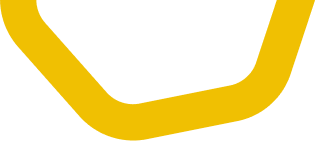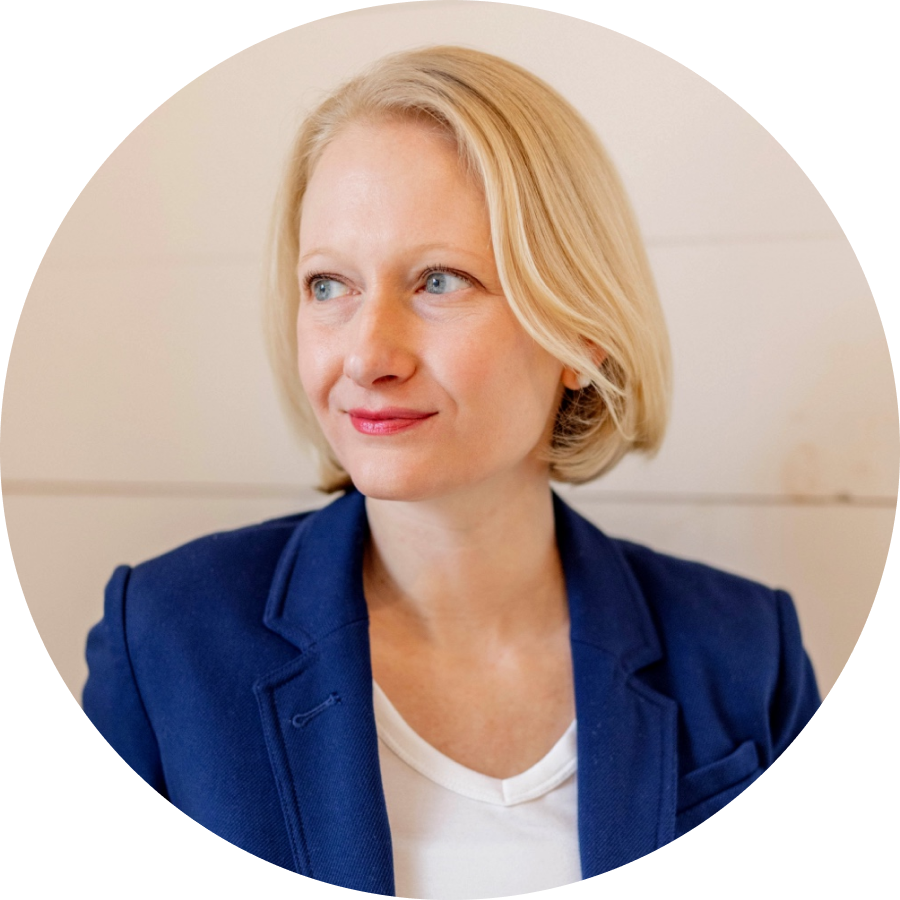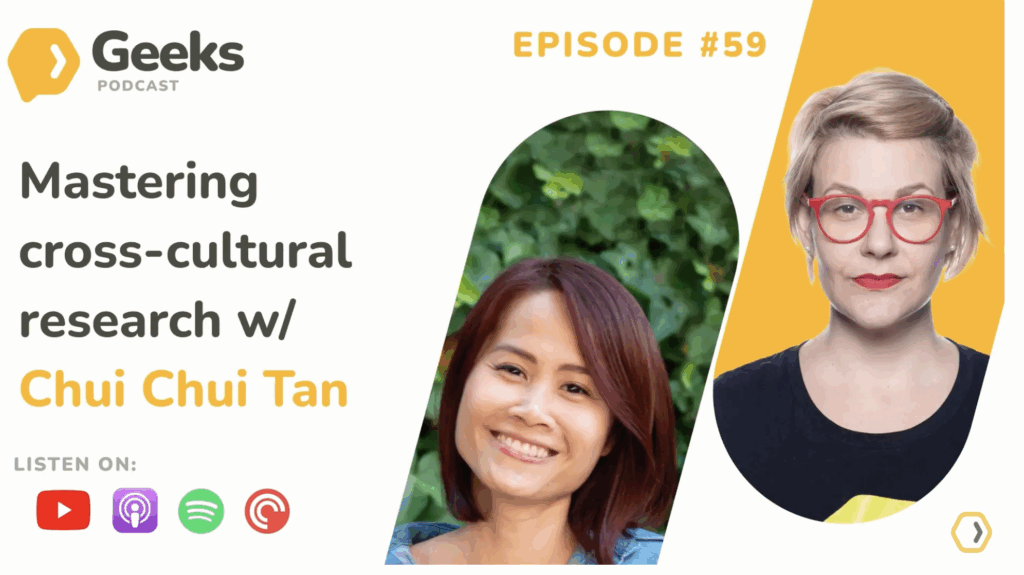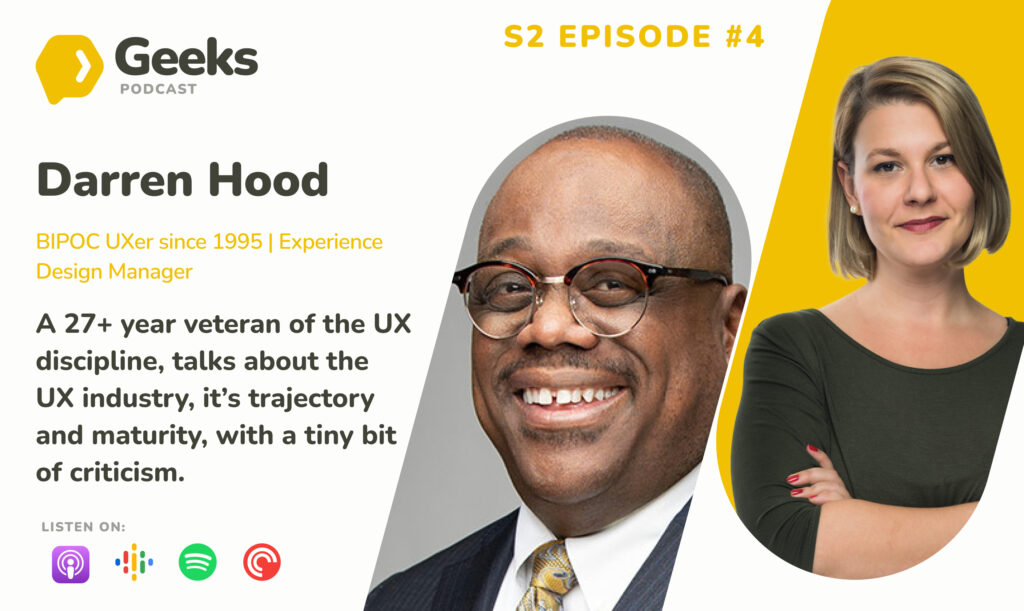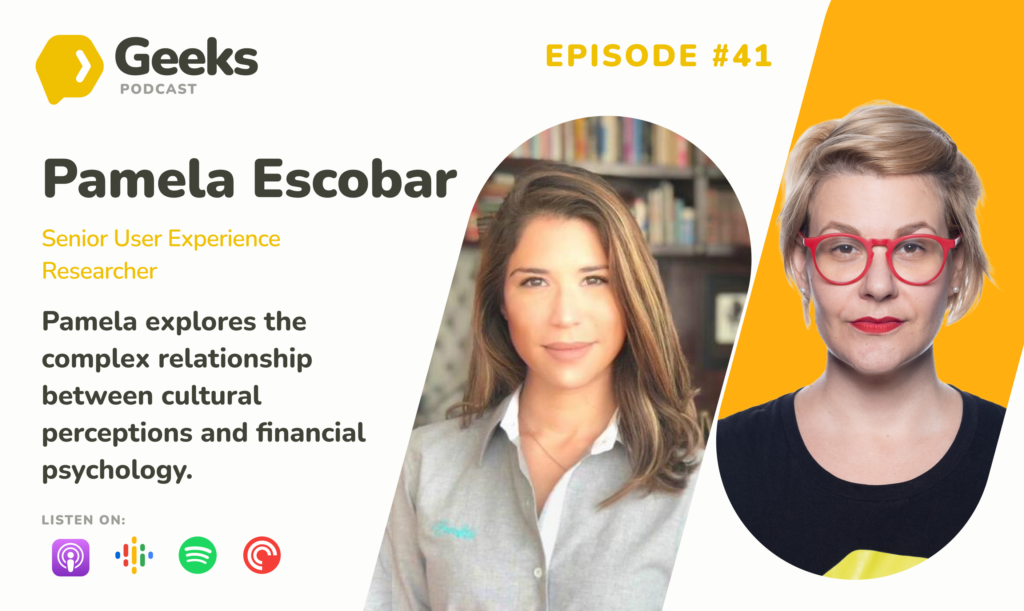If you have any tips on fantastic speakers from across the globe, feedback, or any questions, we’d love to hear from you too. Reach out to geekspodcast@uxtweak.com
Episode highlights
- 00:01:42 – Combining brand and user experience roles at ScreenPal
- 00:12:53 – Methods used to validate and select new brand name
- 00:18:40 – Data-driven rebranding decisions
- 00:21:07 – Communicating the benefits and value of rebranding to leadership
About our guest Kelly Jura
Kelly Jura is a design leader who is driven by the ways that people interact with ideas. Throughout her career, she leverages her deep understanding of brand and behavior, gaining patents, accolades and widespread public acclaim on the way.
Podcast transcript
[00:00:00] Tina Ličková:
Welcome to UX Research Geeks, where we geek out with researchers from all around the world on topics they are passionate about. I’m your host Tina Ličková, a researcher and a strategist, and this podcast is brought to you by UXtweak, an all-in-one UX research tool.
This is the 48th episode of UXR Geeks. In this one, I spoke with Kelly, the vice president of Brand and User Experience at ScreenPal. She shared a journey of rebranding, the company name. And explored the strategic decisions and research that led to the change. In my view, this episode is a must listen for anyone curious about a more holistic approach in our practice. Kelly is showcasing brilliantly how user experience research can make waves in the branding space.
Hello, Kelly.
[00:00:45] Kelly Jura: Hi!
[00:00:47] Tina Ličková: As per usual, we always ask our guests to introduce themselves because we will, of course, do an intro, but I would like to ask you to tell us about yourself with your own words and what do you do.
[00:01:01] Kelly Jura: Sure. I am Kelly Jura. I’m the Vice President of Brands and User Experience for ScreenPal. We used to be called Screencast O Matic. We have millions of users in 190 countries who use us for knowledge sharing, feedback documentation, things like that for asynchronous communication.
[00:01:23] Tina Ličková: And it’s already interesting that you are saying you are vice president for brand and user experience. And I really like the combo because the brand is usually somewhere customer experience, but this is user experience.
So how did you come to this symbiosis?
[00:01:42] Kelly Jura: So that is a great question. I actually have a background in advertising. And then I went into a marketing and brand strategy and then made the transition about 12 years ago into technology. And when I think about user experience, I think about all of the different touch points that a customer can interact with when they’re interacting with your company.
So that doesn’t mean just solely the product, just the digital kind of footprint that you have. It means all of those different things that are really on the periphery of the product. So that includes marketing, advertising, the brand itself and interactions with employees. Employees at the company customer support, for instance, that’s certainly an opportunity to improve the user experience for your customers brand is one piece of that brand.
Certainly. has an opportunity to have positive perceptions associated with it. And we know that perception really helps inform how people behave when they’re using your product. So to me, brand and user experience really go hand in hand. They really shouldn’t be separate pieces of the company.
[00:02:57] Tina Ličková: I completely agree or we are here not to agree or disagree, but I just had a presentation with one of my potential clients about where does, or what is service design customer experience and UX, and it was really hard to tell where the branding. Lies in those disciplines but you were already mentioning it.
And this is something that I’m super interested in because you shared a case study and it’s really close to the branding perspective as well. You approached it with your team very “researchery” wise. So could you tell us more about it?
[00:03:37] Kelly Jura: Sure.
Over about a six year period Screencast-O-Matic, the company that I joined in 2018 went through a research. A really extensive research phase that led to the renaming and rebranding to ScreenPal.
[00:03:53] Tina Ličková: How, why did you decide to even go into a rebranding, renaming?
[00:03:59] Kelly Jura: So there were a few challenges with the Screencast O Matic name. It certainly had practical challenges and it really didn’t fit the long term vision of the brand. Originally, we started as a screencasting company in 2006. It was all about creating quick little capture videos to share ideas, document code and provide feedback to people.
But our product has really grown far beyond screencasting to include video editing, screen capture for documentation, screenshots, screenshot editing. A full hosting platform that also included interactivity and quizzing. So you could add quiz questions and poll questions. And it just, it really grew beyond the original scope of the product.
So while the Screencast-O-Matic was originally pretty descriptive, it really didn’t fit what we had become. And then… Piece of it is that among fans, it is just, it’s a mouthful, right? It’s really difficult to say. It’s really difficult to type. Even among power users and our advocates out there, the name was a big challenge.
16 characters. We actually had a brand mark an icon in the logo itself. So people didn’t know if you actually pronounce that as an O. Just it really created not only a lot of brand problems, but it created a lot of user experience problems. And this is certainly where those two start to overlap.
Last kind of piece was that we really had started out in education. We were heavily adopted And K through 12 education, as well as in higher ed for teachers and professors to capture their lectures and share with students. But we really wanted to get also into employee onboarding knowledge, sharing within companies and the name Screencast-O-Matic had raised a lot of credibility issues amongst our business users. We were hearing that feedback a lot of people were unsure if they wanted to recommend a company called Screencast-O-Matic to their employer or, is this something that I really want to expense? It certainly did raise some credibility issues.
So there were a number of reasons why we were thinking about rebranding, but It’s really interesting when you’re dealing with a problem like this, it’s really easy to let those kinds of personal preferences and biases creep in. So that’s why this really did take on kind of a really large research phase,
[00:06:35] Tina Ličková: So it didn’t just come from, okay, we changed and we need to somehow mirror it in our brand, but it was actually based on some feedback from the people. That where your customers already or your users?
[00:06:51] Kelly Jura: Yeah, true. And we were doing kind of social listening and things like that. It’s really funny because again, power users, these are people who advocate for us, who really love us. If you went on Twitter, we actually in the brand monitoring had seven or eight variations of our name, screen o matic, screen matic, screen cast o. And these are people who love our products and they’re not, they either don’t know the name or they think the name is so much of a mouthful that they’re just unwilling to commit to the full name. I will say though, I do think the original intent of the name was good. It was funny. I was doing this exercise recently where I just plugged in screen customatic and chat GPT and said, based on this name, what do you think that this company does? And. The result was really good. It sounded very favorable. It basically said, a really approachable, playful way to streamline or automate screencasting that easy approachable style was really what we were going for. We’re not going for video producers. We’re going for teachers or product teams who are looking to quickly capture and share their content.
So I think the intent was right. The execution and the actual name though, when you think about it being really approachable, it really read more as being unprofessional when you think about it being streamlined automated, I think that sounds good. But the flip side of it is when you’re creating videos to share, there’s this human aspect, right? And that kind of robotic name didn’t really fit with that either. And then we did, we liked the easiness of the products, but the name itself was so difficult. It was really difficult to type, to say even as I said, our power users didn’t even want to use the full name and it was a little bit of a head scratcher for a number of people who weren’t familiar with Screencast-O-Matic at the time.
[00:08:48] Tina Ličková: I wanna just point out one thing and that is the social listening that you are mentioning, that you are actually looking into social media. ’cause this is something that I hear now and then from UX researchers or researchers in digital space. But I think in us it’s a little bit more used and looked at and I think it’s really important for the important part of desk research, and we are not doing that enough desk research. And this is a part of where that really comes handy when you are looking at the experience and the brand experience. So thank you for mentioning that. And when it comes to the name, I also still have trouble pronouncing it.
And we’ve also been talking about how it was. Accepted or not accepted in the different cultures and with different target groups. So who are the people who you were speaking to in the research part?
[00:09:45] Kelly Jura: So this was a really unique challenge because we were already adopted globally, and we were really ingrained in education and ed tech. So the 1st step was talking to our users and really understanding if they were open to a change here. We certainly, because we were adopted, we love our users.
We had phenomenal users that provided us with. Great feedback. Anytime we ask them for feedback they delivered. We wanted to make sure we weren’t alienating anyone. And we really wanted to understand where the equity was. And one of the insights that we really came to in this process was that the equity itself was in the product.
It was not in the brand name at all, which to me was wonderful because we could transfer that equity very easily to a new name. One of the things that we heard time and time again was, I don’t care what you call it, but don’t change the product. And to me, that was kind of music to my ears. I really liked hearing that. Once we could handle our users, we went out to potential users and we asked them, for the first time hearing Screencast O Matic, what do you think? And it was very clear across all audiences, even our own audience that the name really didn’t resonate with them. It really didn’t connect with people at large. And across geographies, people found the name to be silly, unprofessional some of those words we kept hearing and then what we ended up doing was we ended up testing our current name. Against competitors’ names, and we found the same to be true that people just overall didn’t find Screencast-O-Matic to be something that they were excited to use or advocate for.
So then we tested with a number of new names, a number of new ways that we could respond to those learnings and we did this. It was over a few years. We tested both names. We tested platform statements to understand what was really resonating with people as far as how we communicate what we do to people. And then we actually did go to visual brand testing. We looked at trademark availability across different geographies. And then we did look at cultural and linguistic analysis. So it was really important because we do have a global user base to look in different markets and make sure that we weren’t introducing a name that was, something that might have a connotation that’s negative in different cultures, or there might be, different implications in different cultures or in different languages. So we really did take the time to get this right. I think that was one of the key takeaways here. It was not a fast process, but every step of the way, we really did learn something new, which was really valuable.
[00:12:41] Tina Ličková: And you were mentioning a little bit about the activities that you did, but what were the main methods to get there to approve or verify the new names and to choose from them?
[00:12:53] Kelly Jura: So we did conduct customer surveys. We did a lot of customer surveys. We did customer interviews. We did overall just brand audits. And we looked at the market, the competitive landscape. We did a lot of that kind of analysis internally. We did a lot of max diff. Kind of framework to understand where people ranked our name or our existing name.
And then those other potential names, those other ways of responding to those learnings against each other. So each round of that, we would have the winner for the next rounds. And we bracketed it so that we would have our top 2 names from this round. We would.
Pull those forward and run a new batch with a couple of new names. And then we would do that across markets and across industries. So we were also looking at HR training and development because that was definitely an opportunity area for us. So we did look at different professions and then we did look at different geographies to understand if there were any kind of. Implications for different cultures.
Can you maybe share what implications you experienced in the research? Yeah, so screencast o matic unfortunately, let’s say we had, six places it regularly across markets, across industries, across professions, it was always in the last place. People just did not like that name when we ran it. Had more positive terms and we had negative terms.
People would relate Screencast O Matic more to the negative terms. And that happened again across geographies. By the time we got to ScreenPal, we were feeling pretty confident about ScreenPal, but we did the same exercises. And ScreenPal always came back with more positive terms, but it maintained the ease of use. It maintained the approachability and the friendliness that we really liked about ScreenCast O Matic, about the intent of ScreenCast O Matic. So I would say, some of the insights were that Our existing name was, in fact, not liked, which is 1 of those things, internally, we had this idea that it was not liked. But we really again, we didn’t want our own internal biases. We’re really close to this, right? And. We wanted to have the confidence of being able to look at the data across these regions and be able to make this informed decision because it was a really big decision. This company has existed for over 10 years. So it was really important that we got this right. Overall screen pal was the clear winner. Amongst competitors names amongst other names that we were testing.
[00:15:43] Tina Ličková: Now I will allow myself to provoke a little because if I hear it took about six years to come there, this is something when some product managers or some business owners are listening to us, or anyhow, in real life, it’s happening a lot where they blame us researchers to being slow discipline.
[00:16:05] Kelly Jura: Yes.
[00:16:06] Tina Ličková: How did you actually make sure that the business understands that it needs this time?
[00:16:12] Kelly Jura: I was very fortunate. I will say because the leadership within the company wanted the research, they were willing to put in the time for the research.
I will say that one of the reasons for the really big time lapse was because of the pandemic, because we were highly adopted in education. In 2020 when schools immediately went hybrid and remote. We actually had to put the rebrand and the rename on a shelf. We had to wait, because our focus really shifted overnight into helping customers. At the time, I think I was closing, a hundred tickets a day from our support desk. The CEO, the CTO, we were all just. Getting people on board answering support tickets and really trying to set people up for success because this was certainly a very high stress time. And people, they were flailing a bit, right? It was a very personally stressful time. But if you add on top of that. You’re an educator and you’re expected to overnight change your method of teaching and connecting with your students. That adds just a huge degree of stress, right?
I was feeling really good about the ScreenPal rebrands and then the pandemic hit and it really did pause our efforts for about two years. But, it’s funny because personally, I’m trying to help customers. I’m trying to understand their experience. We were still collecting a lot of data at that point because we were having a lot of new users.
We were getting a lot of intelligence into our team at that point on how to make the onboarding better, how to make. Setting up a team is easier, things like that. I’m also at the time trying to, my twin sons to get some sort of preschool education. I’m not a preschool teacher.
I have great respect for the preschool teachers of the world. And every night I would go to bed. I still had the rebrand in my head. This was something that it occupied. Brain space. It didn’t go away. And it certainly was this piece where it wasn’t, the grass is greener.
It wasn’t anything like that, but it was just, we have all these customers coming in. We have all of this intelligence coming in, but what if the name was different? What would that look like? And, it was something that definitely kept me up at night. I thought there were a lot of opportunities here.
And the rebrand symbolized a lot of the opportunity for growth. In my mind,
[00:18:40] Tina Ličková: Yeah, but growth in the time of pandemic in the educational field, that feels maybe something for another dimension, I would say.
[00:18:50] Kelly Jura: No, that’s so true. Yeah. And it is funny that you mentioned the time and, feeling like we’re delaying the process.
I, again, am fortunate because the leadership really did want the data and we did realize that we were very lucky. So it made sense for us to collect the data and feel confident in our decision because this was not a small decision if it was changing a headline or a button location or something like that, we would just throw it up, look at it for 2 weeks test it, iterate on it and move about our days.
But this was a really big decision. And, when you’re also dealing with a number of stakeholders, it’s important to have the data too. Bring everybody along for the ride and align everybody on why are we doing this? What are the implications of this? What are the risks? What are the benefits? And I can be impatient, what’s the problem? Let’s understand it. Let’s solve it. And this was not that type of problem to solve. This was a much bigger problem to solve. And there were just so many more implications than doing a new landing page or something like that. So I personally had to slow myself down a number of times. And there were times earlier in the testing too, where we were testing names and I was like, we’ve got it. I’ve got this name, I’m excited about it. And in my head, I’m architecting a brand and an experience and thinking about our product, the digital footprint, what does that look like with this brand name? And we sent it to testing and it didn’t do well. And that’s why we test, right? Because if we went off of our own kind of personal, our gut and, what we’re personally excited about products sit on shelves, right? That’s what happens when you build products based on your own kind of personal excitement about things. That’s why research matters. Sometimes you do have to go a little bit slower. To get it right. But when you build it, and it’s based on that data, it resonates with customers. You’re more closely connected with the customers to get that good feedback in the future. And your product will flourish versus building something really quickly. And putting it, either on a shelf cause people aren’t using it or frustrating users because you have to keep iterating to get it right. Which isn’t ideal either.
[00:21:07] Tina Ličková: You said it for me pretty clearly, but you were also mentioning the talks that you had also in the company and explaining the benefits. How would you explain the benefits to a different leadership or a different company, why they should be rebranding and put the effort into research?
[00:21:30] Kelly Jura: Yeah. Yeah. That’s a great question. I think when you look at branding and you ask people about their brand, their name, things like that, you hear a lot about the history which is super valuable. That is, there’s certainly a place for that, but I think looking at something with fresh eyes, looking at your name and your brand today, what it stands for, how it’s impacting the experience for your users in today’s landscape, does it still fit? And in the Screencast-O-Matic case, it didn’t fit. But we were fortunate enough that it didn’t fit, the consumers didn’t connect with it and it really didn’t set us up for the future vision of the company. So all of those things align. So it definitely made sense for us to do a rename and a rebrand. So I think it’s important. Yes, you have this history, but what’s the equity now? What does it look like today? And then what’s your vision for the future? Does it still fit?
[00:22:37] Tina Ličková: What would be your, I wouldn’t say a recommendation, but maybe some advice or tips for researchers who are getting into this topic or are trying to persuade their leadership on doing maybe some tweaks or rebranding initiatives. What should be their arguments on why it should be done and what does it actually brings to business?
A lot of questions. Together. Sorry for it. I’m wondering what it would be and how would you coach somebody on Yeah, this is what you tell your leadership.
[00:23:15] Kelly Jura: Yeah. So those are great questions. One thing I will say is.
Partnership wherever you can partner with people, collaborate with people, bring people along for the ride. So you get there collectively. When I was undertaking this project, I was very lucky to have the partnership and the support of leadership and they respected my expertise in this. So I was very fortunate. Position and I’m very grateful for that. Not everybody is in that spot but wherever you can partner with other people in the business, do it when you’re looking at, across an organization, your customer support team, they are just, A knowledge base, right?
They have all of this intelligence into what people are struggling with when they’re interacting with support. Go to your social media manager. We talked about that social listening partner with them. Understand what people are talking about when they’re referring to your product, your company, your service, right?
Understand that all of these different aspects really do impact the experience, right? And the more that you could partner with these other pieces of the business to understand what people’s pain points are when they’re interacting with that piece of the business, the better the more informed you can make a case for something like a rebrand. And the more data you can bring, the better. But definitely try to partner as much as you can. It really does depend on the makeup of the organization. If it’s a huge company, that might be a little bit more challenging versus a smaller, more entrepreneurial company. There might be more opportunities, but really wherever there’s an opportunity to partner with other experts at your company, it’s important to do that.
[00:25:06] Tina Ličková: And are there anything that you also maybe experienced on the journey of the rebranding or that you saw in some other businesses where you would say, Oh, better not do this while rebranding
Yeah, so that It’s important to realize when you’re letting bias creep in always with research. Bias happens. You have to acknowledge it. You have to understand why it’s happening and look for ways to eliminate it. We did use some third party researchers, some consultants on this as well, which I found to be incredibly valuable because. When I felt like our team was getting too close to something and I, again, I did have support from leadership to say, why don’t you reach out to this consultant or why don’t you create a budget to use a third party to do some of these panels? I think that was really valuable being able to tap into another user experience researcher, another consumer insights researcher that didn’t have all the baggage and all the weight that we carried as part of the team as it related to this rebrand. So that was another piece that I thought was really important to validate what we were already thinking to use as a sounding board for what we perceived our problems to be and to be able to use those experts in a way that made sense to extend our team without the bias.
I can imagine that the bias in research is overall, we are fighting it every day, even on our own bias, stakeholder bias, but with brand, as you said, there is this history, there is this attachment to the names, to the logos, to everything that came with it. So I can imagine it’s way stronger coming up there.
As the last question, at the end of the day, you renamed You have a new name.
Are you doing any research now to see what it is influencing or how it is perceived? Do you have any data on the reality of the new name in the wildlife there?
[00:27:21] Kelly Jura: Always we are always conducting research whether it’s, market research, design research, we are continually conducting that and making it a priority. Because as I said, when you have the research, when you have those insights, you can make those informed decisions and better the product, better the user experience and make it more enjoyable for everyone.
[00:27:44] Tina Ličková: Is there anything that I didn’t ask you when it comes to this topic or you didn’t have a chance to share?
[00:27:52] Kelly Jura: I would say that it’s really important. I talked about partnership. Earlier I’m partnering with other people in the company, but it’s so important to make sure that the employees in a company are on board with any of these big decisions. Because of the rollout, it took every single person at our company.
We really all needed to be on the same page. We needed to be highly orchestrated. We have a web platform. We have a desktop app. We have mobile apps. We have marketing, we have social, we have a Chrome extension. And we released this brand across platforms, across marketing, across PR efforts within 24 hours. We absolutely could not have done that if we didn’t have the full support of every person on the team. So I think. It’s important to highlight how incredible a launch can be if your employees are on board. So don’t leave them behind. Definitely think about employee experience as part of user experience. And, just as from a leadership perspective, we looked at all of the data. We really felt comfortable in this decision. It was important to bring everybody up to speed on why this was important for our future success and how they fit into this rebranding. And I just feel incredibly fortunate to be part of the team that really brought that together again, within 24 hours, that’s really quite an accomplishment. And we couldn’t have done it without everybody really being on the same page.
[00:29:26] Tina Ličková: That’s something.
[00:29:27] Kelly Jura: Yeah, it really is.
[00:29:30] Tina Ličková: Kelly, thank you very much. Thank you very much for sharing the case study with us and also sharing some very nice details. And thank you very much for your advices.
[00:29:38] Kelly Jura: Thank you so much. I really appreciate it.
[00:30:15] Tina Ličková:
Thank you for listening to UXR Geeks. If you enjoyed this episode, please follow our podcast and share it with your friends or colleagues. Your support is really what keeps us going.
If you have any tips on fantastic speakers from across the globe, feedback, or any questions, we’d love to hear from you too. Reach out to geekspodcast@uxtweak.com
Special thanks goes to our podcast producer, Jana Filušová, our social media specialist Daria Krasovskaya and our audio specialist Melisa Danišová. And to all of you. Thank you for tuning in.
💡 This podcast was brought to you by UXtweak, an all-in-one UX research tool.



